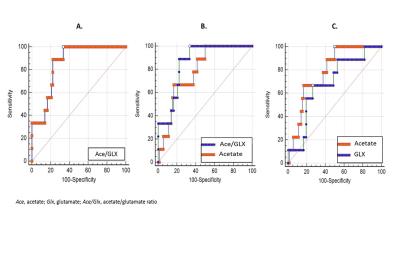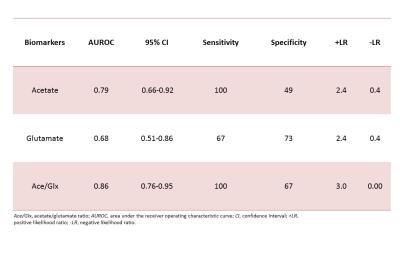5637
Prognostic utility of cervicovaginal fluid acetate-glutamate ratio for risk of preterm delivery within two weeks of presentation with symptoms of threatened preterm labour1Academic unit of Reproductive and Developmental Medicine, University of Sheffield, Sheffiled, United Kingdom, 2Academic unit of Radiology, University of Sheffield, Sheffiled, United Kingdom, 3School of Clinical Dentistry, University of Sheffield, Sheffiled, United Kingdom
Synopsis
Accurate identification of pregnant women with symptoms of preterm labor (PTL) most likely to deliver prematurely soon after presentation/assessment is crucial for prompt clinical decision making and allocation of scarce resources by minimizing unnecessary hospitalizations and treatments, as well as by triaging patients to the centers with optimal care facilities. We determined the predictive capacity of cervicovaginal fluid (CVF) acetate/glutamate ratio in pregnant women presenting with symptoms of threatened PTL using 1H-NMR. The ratio of CVF acetate to glutamate demonstrated better prediction of delivery within 2 weeks of symptomatic presentation, compared to either acetate or glutamate alone.
Introduction: Preterm delivery (PTD, before 37 completed weeks of gestation) remains the leading cause of perinatal morbidity and mortality globally. Majority of women presenting with symptoms of threatened preterm labor (PTL) do not eventually deliver preterm, necessitating better prognostication of pregnant women with threatened PTL most likely to imminently deliver preterm.1 We previously showed that decreased cervicovaginal fluid (CVF) acetate appears a suitable “rule-out” marker for delivery within two weeks in women presenting with threatened PTL.2 Also, it has been reported that low CVF glutamate is associated with reduced vaginal fluid acidity and bacterial vaginosis infection,3 an established risk factor of PTD.4 To determine whether glutamate, or other studied metabolites, enhanced the predictive ability of acetate for preterm delivery within 2 weeks of the assessment, we examined the combined discriminative capacity of the two CVF metabolites in pregnant women presenting with symptoms suggestive of threatened PTL.
Methods: CVF was obtained by high-vaginal Dacron swabs from 82 symptomatic women with singleton pregnancies (24 - 36 weeks gestation), intact fetal membranes and no evidence of genital tract infection or abnormal cervical cytology. Samples were dissolved in 600 µl Phosphate Buffered Saline from which a 400 µl NMR sample containing 20 µl D2O was analyzed by 1H-Nuclear Magnetic Resonance (NMR) spectroscopy using a 400 MHz Bruker Avance III NMR spectrometer, with 5mm Broadband Observe probe using a Watergate water suppression pulse sequence (NS = 256, D1 = 5s, AQ = 1s, SW = 20.6 ppm, TD = 16446). Acetate, glutamate and other metabolites implicated in vaginal host-microbial activities, infection and PTD were identified in the 1H-NMR spectrum (Fig. 1), and confirmed by 2-dimensional 1H-1H and 1H-13C NMR correlation experiments. Metabolite peak areas were integrated and normalized to the total spectrum integral (excluding residual water peak between 4.7 – 5.0 ppm). The ratio of acetate to glutamate normalized integrals (Ace/Glx) was then ascertained and compared between the study cohorts using Wilcoxon–Mann–Whitney test and Area under the Receiver Operating Characteristics (AUROC) curve (MedCalc Software bvba, BE, USA). Predictive endpoint was delivery within 2 weeks of index assessment/sampling.
Results: Nine (~11%) women delivered within 2 weeks of index assessment and showed significantly higher CVF acetate (mean ± SEM: 0.03 ± 0.01 vs. 0.02 ± 0.003, P = 0.005) than those who delivered later than 2 weeks. Although the decrease in glutamate was only of borderline significance (0.009 ± 0.001 vs. 0.012 ± 0.001, P = 0.07), the combination of acetate and glutamate normalized integrals expressed as ratio (Ace/Glx), was significantly higher (5.0 ± 1.9 vs. 1.4 ± 0.18, P = 0.0002) in the same women (Fig. 2), and indicated better prediction of delivery within 2 weeks of index assessment (AUROC = 0.86) (Table 1 and Fig. 3A), compared to either acetate (AUROC = 0.79) or glutamate (AUROC = 0.68) independently (Table 1 and Fig. 3B-C). The 1H-NMR normalized integrals for succinate, lactate, formate, glucose, alanine, creatine/creatinine and branched chain amino acids did not differ significantly between the cohorts and were not predictive of delivery within 2 weeks of assessment.
Conclusion: The combination of decreased CVF glutamate with increased acetate in symptomatic pregnant women improves prognostication of delivery within 2 weeks of presentation with symptoms of threatened preterm labor, compared to either acetate or glutamate alone, and may improve the triaging of symptomatic pregnant women at risk of imminent preterm delivery, allowing patients to be discharged to outpatient care whilst sign-posting neonatal high-dependency care to those at highest risk.
Acknowledgements
We are grateful to the women who consented to partake in these studies and to the service user involvement panels who provided profitable guidance during the planning and execution of these experiments.References
1. Tsiartas P, Holst RM, Wennerholm UB, et al. Prediction of spontaneous preterm delivery in women with threatened preterm labour: a prospective cohort study of multiple proteins in maternal serum. BJOG 2012; 119:866-873.
2. Amabebe E, Reynolds S, Stern VL, et al. Identifying metabolite markers for preterm birth in cervicovaginal fluid by magnetic resonance spectroscopy. Metabolomics 2016; 12(4):1–11.
3. Srinivasan S, Morgan MT, Fiedler TL, et al. Metabolic signatures of bacterial vaginosis. MBio 2015; 6(2):e204–15.
4. Lamont RF. Advances in the Prevention of Infection-Related Preterm Birth. Front Immunol. 2015; 6:566.
Figures



